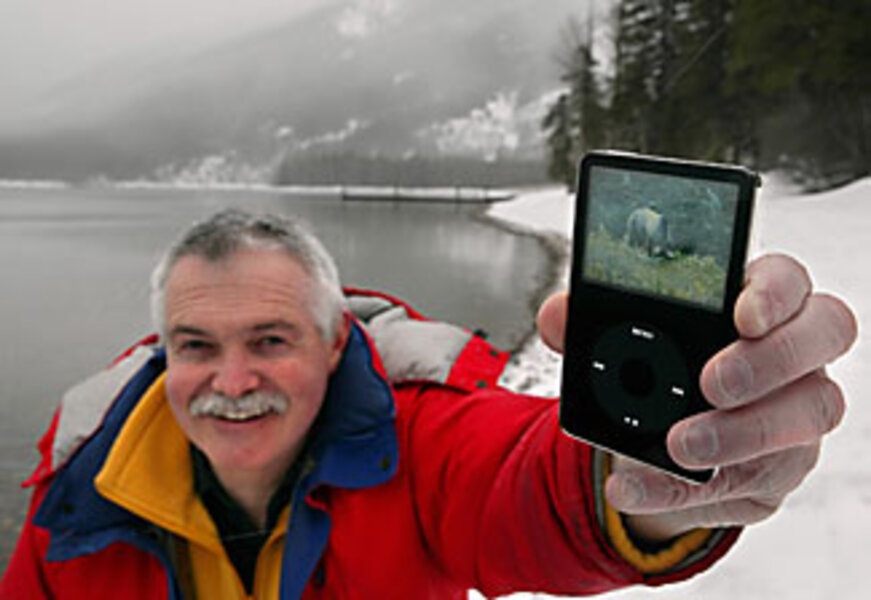Now students take field trips online
Loading...
| Stockton, Calif.
When seventh graders in Stockton took a field trip this week to see elephant seals, they didn't even step outside their school. Instead, with the help of a projector and a video camera, the students teleconferenced with a state park guide on the California coast.
Across a distance of 100 miles, students on the so-called "virtual field trip" got to talk with the guide, watch seals throw sand on themselves, and hear the blubbery beasts belch and bark – all without a yellow bus or permission slip.
"If you can't go somewhere, this can be the next best thing," says Craig Wedegaertner, an administrator at Marshall Middle School in Stockton. "Or, it can be used to prepare [students] before they go there."
As the days grow long and the school calendar short, field trip season is in full swing. But with fuel prices rocketing, some schools are discovering virtual field trips as a cost-effective way to add new – or farther afield – excursions.
"We are beginning to reach the tipping point" with virtual field trips, says Ruth Blankenbaker, executive director of the Center for Interactive Learning and Collaboration (CILC) in Indianapolis.
As of last month, more than 1,125,000 students have participated in virtual field trips organized through the CILC website alone. Some 150 institutions – from National Aeronautics and Space Administration to the Bronx Zoo – list trips on the site, and each month sees another three or four additions.
The technology has been around for years, but it's only now gaining widespread adoption in classrooms, says Ms. Blankenbaker. There are several reasons: more schools with broadband, wider options for trips, rising costs for travel, and falling prices for teleconference systems.
"With this technology, you have erased the geographic boundaries of your field trip experience with one $1,500 to $5,000 expenditure [on equipment]," she says.
For instance, US students can talk with divers on Australia's Great Barrier Reef, practice their Spanish with kids in Costa Rica, or listen to stories told by Pearl Harbor survivors at the USS Arizona memorial in Hawaii.
When Pluto was demoted as a planet, Cheryl Dultz's set up a teleconference with a NASA educator who explained the reasons for the demotion to her third grade class in Citrus Heights, Calif.
Like many proponents of the trend, she dislikes the term "virtual field trip" because it suggests that virtual trips might replace, rather than supplement, traditional trips.
"It would never take the place of a field trip, and in fact, I take as many field trips as I did before," says Ms. Dultz. "I use the tool as an opportunity to have my students interact with experts in the field."
That's what organizations hosting virtual field trips are hoping. California State Parks, for instance, set up the elephant seal trip to introduce a new, more diverse generation to the parks – and spur interest in eventually visiting.
The goal is laudable and part of pioneering efforts by park systems across the country to reverse declining attendance, says Richard Louv, author of "Last Child in the Woods."
"The problem is I can see school districts saying, 'Why should we pay for buses if we can just do this?' " he says. "Classroom learning about nature is terrific, including a virtual field trip. But I would not classify that as experience. What kids are missing now is not information. What they need most is the hands-dirty, feet-wet experience in nature."
Many a school trip to the ocean has foundered on the expense and scheduling nightmares involved with busses. And that's before diesel topped $4 a gallon.
"Fuel is the biggest reason currently for reducing field trips or cutting them altogether. In fact, it's officially reached a dilemma," says Ryan Gray, editor in chief of School Transportation News. He says some 40 states will enter the 2008-09 school year with a deficit in transportation funding.
Virtual field trips, by comparison, are often free once the school invests in the equipment. The cost of one teleconferencing system, says Marshall Middle School Principal Ron Small, is only slightly higher than that of busing two classes to see those elephant seals in person.
That said, Dr. Small emphasizes that he doesn't anticipate reducing traditional trips. He still plans to send his students to the state capitol. But the students might later do a teleconference with their state representative.
Beyond cost, virtual trips can often be more focused and easily aligned to educational objectives, says Small and others.
"Take the kids to the zoo and they are all over the place. Take them the Bronx Zoo, virtually, and they can go behind the scenes and see the hairs in a buffalo's nose," says Blankenbaker.
The California state parks program, which reaches about 20,000 students a year, designed the elephant seal trip around the seventh grade curriculum on evolution.
Dressed in a park uniform and hat, guide John Goldberg asks the class of 24 students what adaptations the seals have developed for keeping warm in the Pacific waters. The kids raise their hands, their attention still holding steady after 40 minutes. Mr. Goldberg can see the kids, but lets their teacher call on students since he doesn't know their names. Someone comes up with body fat. Goldberg calls it "blubber" and wins some playful giggles.
After the bell rings, the students say goodbye to Goldberg. One says: "I'm going to come to your park."





